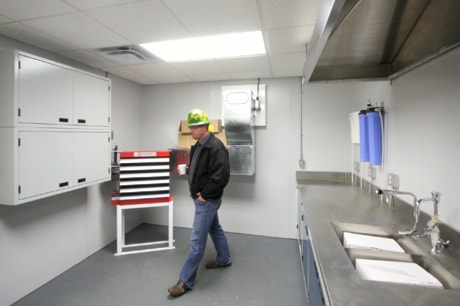If an explosion were to occur at Nexen Inc.’s upgrader at Long Lake, the safest place there should soon be the laboratory.
That’s because the lab’s steel enclosure has been designed to withstand a blast pressure of eight pounds per square inch — about the same as a reinforced concrete bunker. Fabricated by Pro-Tec Storage Solutions, a division of Red Deer-based X-treme Energy Group Inc., the six-metre by three-metre by three-metre building is sitting in Innisfail awaiting shipment to the upgrader northeast of Edmonton.
“There are several other manufacturers globally building these types of structure,” said Pro-Tec manager Tony Smethurst. “But the one that we built is most innovative in how it’s built and how it’s designed.”
For competitive reasons, Smethurst couldn’t elaborate on that design — other than to say it utilizes a unique panel structure, clad inside and out with heavy steal. Boasting such features as an air exchange system, gas detection monitors and alarms, it weighs nearly 16,000 kg, he estimated.
Although the lab is Pro-Tec’s first blast-resistant module, Smethurst is optimistic similar projects will follow. Nexen has already indicated that it needs another lab, and several other oil companies have expressed interest as well.
“They’re waiting to see the Nexen building.”
Fuelling this demand are new petroleum industry guidelines that resulted from the 2005 explosion at a BP refinery in Texas City, Tex. Fifteen workers were killed and more than 170 were injured in that incident.
Companies across North America are now likely to add blast-resistant modules for use by personnel in higher-risk areas, said Smethurst. These could range from lunchrooms to offices.
“It’s just kind of in the infancy of the industry but it will probably be one of the higher growth industries.”
Pro-Tec is well positioned to fill the void. It’s been building specialized structures for more than 20 years, starting with facilities for the storage of flammable and combustible materials.
Previously part of Laden Steel Fabricators of Innisfail, it came under the X-treme Energy umbrella when X-treme purchased Laden a few years ago. The fabrication plants remain in Innisfail.
Pro-Tec’s current range of products include pressure-testing enclosures, explosives magazines, a variety of storage containers and mobile emergency showers.
The last product has proven particularly popular with the United States military, which has deployed these in most of its foreign theatres of operation to protect personnel from the threat of chemical exposure, said Smethurst. The showers are also used in the petroleum and chemical industries.
Pro-tec’s development of custom hybrid buildings stimulated research, which in turn opened new doors.
“The blast-resistant module kind of fell out of that R&D,” said Smethurst, adding that work on the original design began about 16 months ago.
Third-party engineers used computer software to assess the Pro-Tec building’s resistance to blast waves. Eight pounds per square inch, which is at the lower end of what the structure can withstand, would equate to a total force of approximately 300,000 pounds against a long wall of the Nexen lab, calculated Paul Schmur, who manages X-treme Energy’s special projects.
“We are, as far as I know, the only Canadian fabricator or manufacturer that is doing this,” said Smethurst of the blast-resistant buildings.
That places Pro-Tec in a good position to supply the needs of Canadian petroleum companies — and others in the United States and beyond — from its Innisfail plant.
hrichards@www.reddeeradvocate.com
